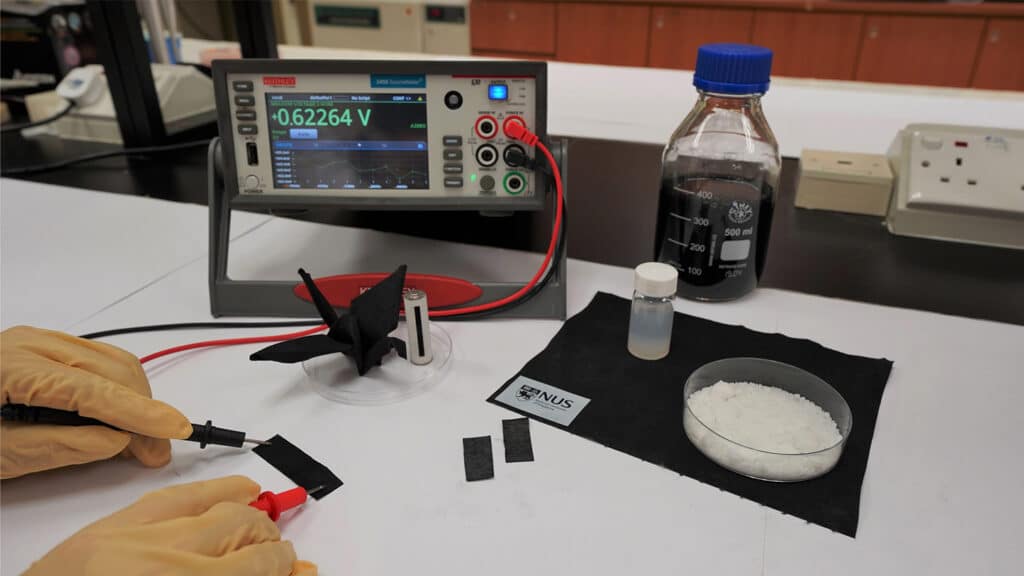Researchers from the National University of Singapore’s (NUS) College of Design and Engineering (CDE) have developed a new moisture-driven electricity generation (MEG) device made of a thin layer of fabric – about 0.3 millimeters in thickness – sea salt, carbon ink, and a special water-absorbing gel.
The concept of MEG devices has been receiving growing interest due to its potential for a wide range of real-world applications, including wearable electronics like health monitors, electronic skin sensors, and information storage devices. But current MEG technologies include water saturation of the device when exposed to ambient humidity and unsatisfactory electrical performance.
To address this problem, the novel MEG device contains two regions of different properties to perpetually maintain a difference in water content across the regions to generate electricity and allow for electrical output for hundreds of hours. The device consists of a thin layer of fabric – made of wood pulp and polyester – which was coated with carbon nanoparticles.
Researchers coated one region of the fabric with a hygroscopic ionic hydrogel, and this region is called the wet region. Made using sea salt, the special water-absorbing gel can absorb more than six times its original weight, and it is used to harvest moisture from the air. And the other end of the fabric is the dry region which does not contain a hygroscopic ionic hydrogel layer. This is to ensure that this region is kept dry and water is confined to the wet region.

Once the device is assembled, electricity is generated when the ions of sea salt are separated as water is absorbed in the wet region. The free ions with a positive charge are absorbed by the carbon nanoparticles, which are negatively charged. This causes changes to the surface of the fabric, generating an electric field across it. These changes to the surface also give the fabric the ability to store electricity for use later.
With the unique design of wet-dry regions, NUS researchers were able to maintain high water content in the wet region and low water content in the dry region. This will sustain electrical output even when the wet region is saturated with water.
“With this unique asymmetric structure, the electric performance of our MEG device is significantly improved in comparison with prior MEG technologies, thus making it possible to power many common electronic devices, such as health monitors and wearable electronics,” explained Assistant Professor Tan Swee Ching, who led the team. In addition, the NUS team’s MEG device is highly flexible and can withstand stress from twisting, rolling, and bending.
Due to its ease of scalability and commercially available raw materials, the MEG device has immediate applications, for example, for use as a portable power source for mobile powering electronics directly by ambient humidity. “After water absorption, one piece of power-generating fabric that is 1.5 by 2 centimeters in size can provide up to 0.7 volts of electricity for over 150 hours under a constant environment,” said research team member Dr. Zhang Yaoxin.
The NUS team has also successfully demonstrated the scalability of its new device in generating electricity for different applications. In lab tests, they connected three pieces of the power-generating fabric together and placed them into a 3D printed case that was the size of a standard AA battery. The voltage of the assembled device was tested to reach as high as 1.96V, which is enough to power small electronic devices such as an alarm clock.
“Our device shows excellent scalability at a low fabrication cost. Compared to other MEG structures and devices, our invention is simpler and easier for scaling-up integrations and connections. We believe it holds vast promise for commercialization,” shared Asst Prof Tan.
A self-charging fabric that generates electricity from air moisture
Source: Tambay News

0 Comments